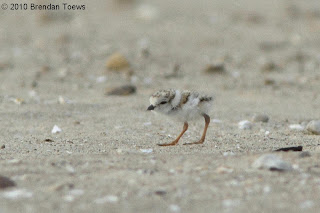Nest Updates from Piping Plovers at Sauble Beach
 As we’ve been updating throughout the season, Endangered Piping Plovers have returned to Sauble Beach this year. Here is the latest news from Kim and Brendan Toews:
As we’ve been updating throughout the season, Endangered Piping Plovers have returned to Sauble Beach this year. Here is the latest news from Kim and Brendan Toews:
11 June, 2010
Nest 1 (F1 & M2): Several fox were seen in the area with 4 being observed inside the perimeter fence. Three plovers were flying in loops over the area. F1 and M2 were switching-off of the scrape. This pair were off their scrape twice for 15-20 minutes.
12 June, 2010
Nest 1 (F1 & M2): F1 and M2 have abandoned their scrape due to predation. F1, M2 and a single male were in front of the nest perimeter. Both males were digging scrapes. M2 flared his wings (courtship), but F1 left the area. A single male plover was observed close to F1.
A fox wearing a collar was observed attempting to enter the nest. The fox’s collar kept catching on the bottom of the exclosure. The Ministry of Natural Resources investigated and found that an animal had burrowed into the exclosure and taken the eggs.
21 June, 2010
Nest 2 (M1 & F2): First hatch! We have 3 soon to be day old Piping Plover chicks on the beach. Two chicks hatched earlier today and the third later this afternoon. There is still one egg from this clutch that has not hatched at this point. M1 and F2 continued to switch-over brooding the three young chicks and incubating the egg.
F1 (female from Nest 1): This female and her mate (M2) lost their nest to predation. F1 may have a new mate and there have been positive indicators of her attempting to renest. We are awaiting confirmation of the leg bands on this male.
22 June, 2010
Nest 2 (M1 & F2): Three chicks were observed in the early morning after which we saw only 2 until the evening. Guardians were reasonably sure that they saw an egg in the scrape in the morning, but heavy rain and fog limited their viewing. The weather cleared and it became quite warm. Four chicks were observed brooding and moving around the open beach. Two chicks moved 20-30 metres away from the adult, while two stayed close and brooded more often. One chick in particular seemed much smaller and was brooding more often. We are guessing that the two older chicks might be the most active. Both adults shared brooding duties. Four chicks are foraging successfully as they were observed picking up insects and worms.
Nest 3 (F1 & M3): This female has paired up with a new male (M3). Guardians are monitoring the nest, with no activity being observed today.
Thanks for the updates, Kim and Brendan! We can’t wait to hear more about the chicks and whether or not any more nests are successful.
Photo by Brendan Toews, btoewsphotos.zenfolio.com



